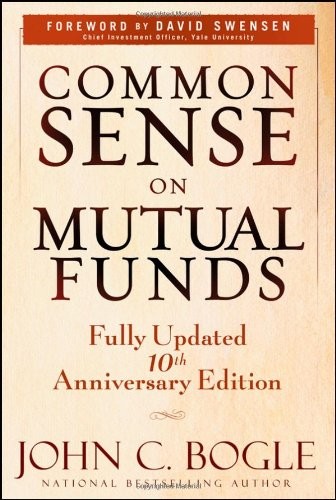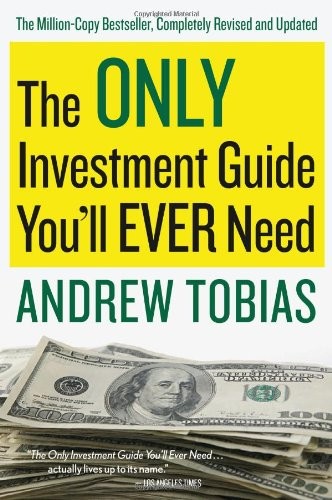Customer Reviews The Little Book of Common Sense Investing The Only Way to Guarantee Your Fair
Post on: 1 Май, 2015 No Comment

190 of 193 people found the following review helpful
4 Quick and simple introduction to index investing
By Vasiliy Zhulin on June 27, 2007
John Bogle created the world’s first index fund in 1975. In this book, he describes why you should make index funds the core of your investment portfolio.
Bogle starts off with introducing index funds through a parable that describes how middle-man costs in finance eat away at investors’ profits. He discusses why speculation doesn’t work and why business reality (in his definition, divident yields plus earnings growth) is more important that market expectation (changes in P/E based on what investors are willing to pay for various equities).
Bogle spends a few chapters discussing various problems with regular actively managed mutual funds, covering issues with performance (he asserts that less than 1% of all mutual funds were able to beat the market consistently over the past half century), various costs (expense ratios, sales charges, advertising fees, turnover costs, tax implications), poor market timing, and finally the difficulty of choosing a mutual fund (he states that there’s no good way to pick a fund, since we can’t foretell the future, and past performance is not an indicator of what’s to come). He brings the reader to the common sense conclusion that index funds, in their pure simplicity, are the logical choice for any investor, as they provide the diversified return of the entire market with miniscule fees and minimal effort.
The last few chapters cover bond funds, ETFs, and a few pages of investment advice — which boils down to keeping at least 50% (if not all) of your money in broad-market index funds. Interestingly, Bogle spends a chapter discussing what Benjamin Graham would have thought about index funds, citing various quotes from Graham’s The Intelligent Investor and certain blurbs from Warren Buffet. He, of course, concludes that Graham would have praised index funds.
So, did I like the book? Yep. it was pretty good. Bogle writes very clearly and visibly tries to keep his discussions simple and to the point, so as to appeal to the widest possible audience. And with good reason! Bogle’s advice is very applicable to the many individual investors today — index funds are a great low-cost and low-maintenance way to get your share (or all, as Bogle suggests) of the market’s return.
To convince the reader, Bogle uses many diagrams to illustrate returns of various mutual funds vs. index funds, and to compare what your original investment would look like after a certain time — based on how it was invested. I found an error in one of the diagrams — exhibit 10.1 (and the text around it) on page 108 lists the average fund advisor return as $188,500 instead of $88,500. Not a big deal, but it slightly undermines the point he’s trying to make on that page. Overall, I feel that Bogle’s diagrams illustrate some good harsh realities — he clearly illustrates how a few percentage points (i.e. the costs associated with actively managed mutual funds) can eat away enormous chunks of your money over time.
To bring more authority into his argument, Bogle provides a Don’t Take My Word for It section at the end of each chapter, where he quotes various respected investors and professors to support the points he made in the chapter. I enjoyed this, but it’s important to be aware that some quotes can often be interpreted very differently outside a certain context.
One very obvious issue with this book is that Bogle is selling his own product — Vanguard’s funds. He doesn’t try to hide this in any way. He uses Vanguard’s funds in nearly all examples, and he often hints how his world’s first index fund is the greatest thing since sliced bread. You can’t really blame the man — his contribution to the world of finance and investing is enormous, and he damn well should be proud of his accomplishments. So I think it’s okay to cut Bogle some slack in this area.
The book is short — about 215 small-size pages. You can probably sit down and read it in a few solid hours. It also goes pretty quickly, as the material is not dense and easy to follow. However, some may argue that the book is too long for what it is trying to demonstrate. True, Bogle’s advice really can be summed in just a few pages — index funds are a great choice for the average investor. But I have to say that I enjoyed reading the examples and history that he provides.
In conclusion, I recommend this book to any individual investor. While Bogle’s advice is in no way eye-opening or revolutionary (chances are, you already know that index funds are a very low-cost and low-maintenance way to diversify), it is good to remind yourself the reasons why you should stay away from most actively managed mutual funds. As Bogle describes, this is all common sense — but we’re often blinded by flashy advertisements, hot market sectors, and seemingly-reachable dollar signs. This book is a good reality check for the average individual investors.
I wish I could give this book 4.5 stars — but since I can’t due to Amazon’s rating system, I feel that it is more of a 4-star book rather than a 5-star one. It has solid advice, but it should not be considered the end-all of investing, and some of the advice and quotations should be taken with a grain of salt. Overall, however, it’s a great and insightful read. I plan to buy a couple extra copies to give to my family.
Pros:

+ quick and easy read
+ lots of examples and diagrams to demonstrate how high expense ratios and other hidden costs can devastate a portfolio’s return
+ some good basic investment advice: buy and hold, avoid emotional decisions, don’t be enticed by new hot trends (as by the time you find out about them, prices are already inflated), diversify into the whole market, look into costs before buying, etc.
+ great format — short chapters, useful data, neat quotation sections at the end of each chapter
Cons:
- some may be turned off by Bogle’s plugs for Vanguard funds (this didn’t really bother me)
- may seem lengthy to drive one main point home (but keep in mind that there are quite a few good tid-bits scattered throughout the book)
- take some citations with a grain of salt














